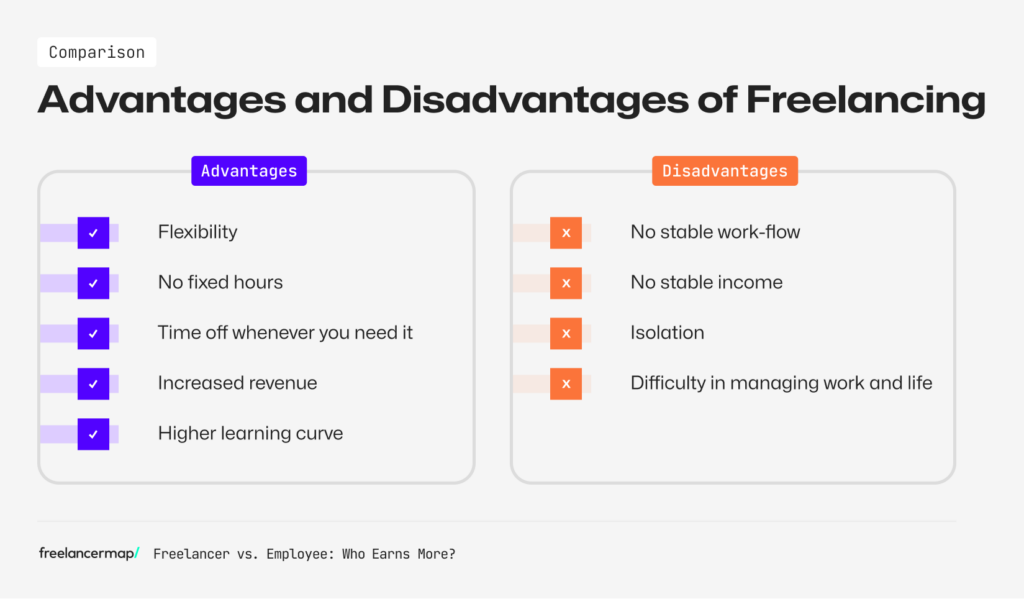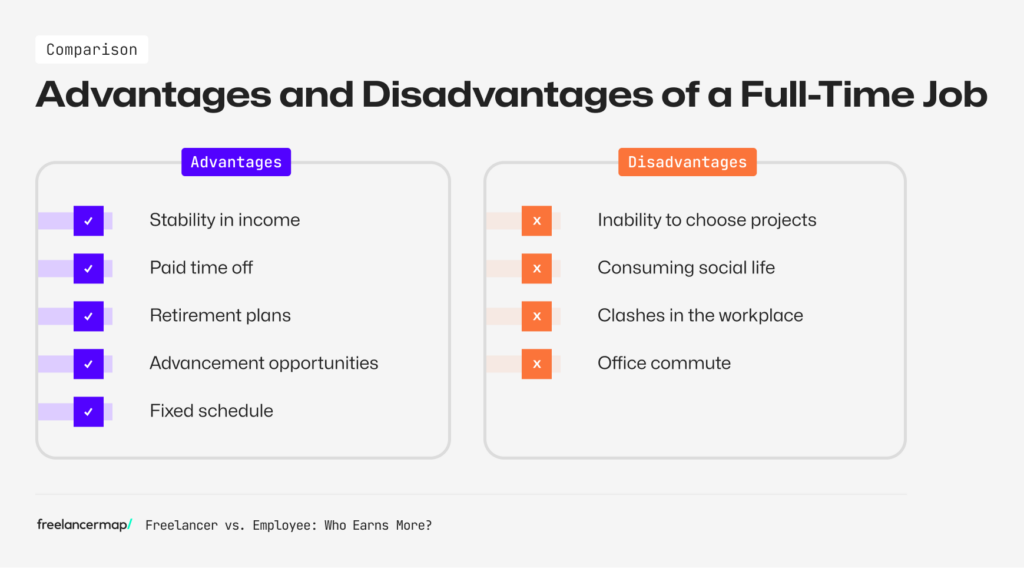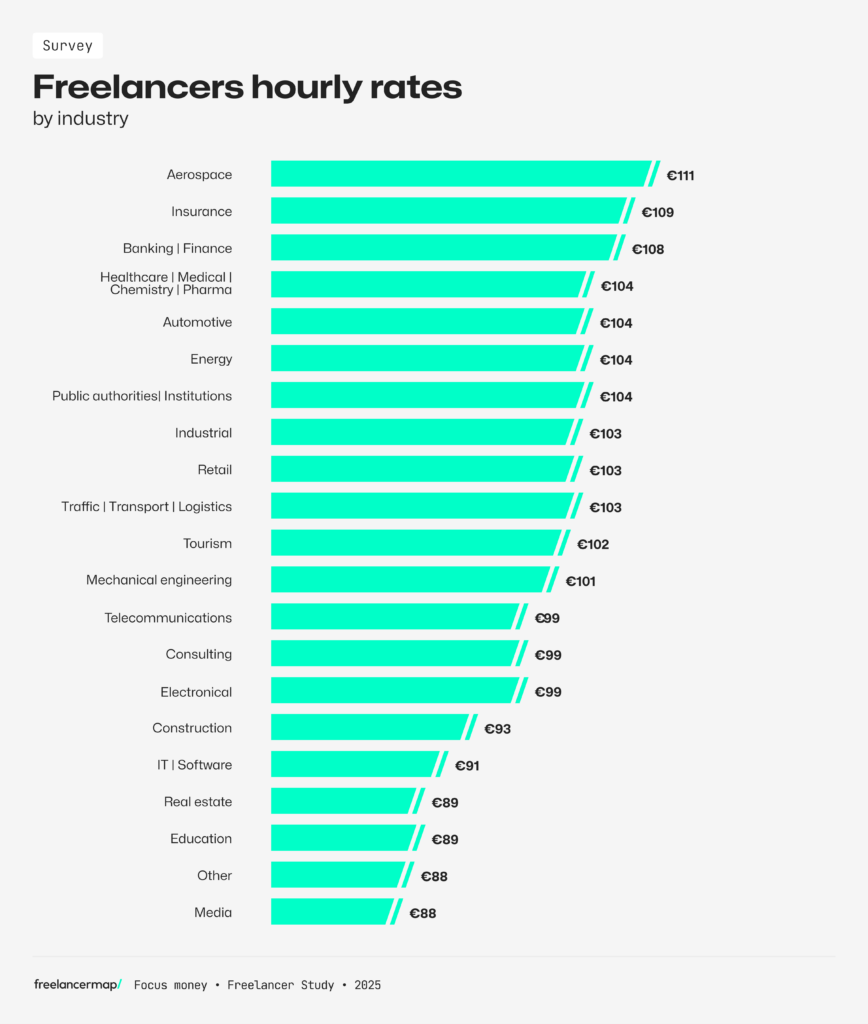Often times, when people consider making the move to freelancing, one of the first lines of inquiry is whether they’d make more or less working on their own than in a typical 9-to-5 full-time job. So, in the battle of freelancer vs employee, do freelancers come out on top?
- Freelancer vs employee: Advantages and disadvantages
- Most freelancers earn more – Salary comparison
- Factors that can affect employee and freelance salaries
- Why do freelancers get paid more?
- What is the average hourly rate of freelancers according to industry?
- Conclusion
Freelancer vs employee: Advantages and disadvantages
Before we delve into the salary comparison between freelancers and employees, let’s first take a look at some of the advantages and disadvantages that both freelancing and a full-time job have to offer.
Advantages and disadvantages of freelancing:
Advantages:
There are loads of advantages of freelancing but some of the most prominent ones include:
- Flexibility
- No fixed hours
- Time off whenever you need it
- Increased revenue
- Higher learning curve
Disadvantages:
Sounds intriguing right? Not so fast! There are also a few disadvantages that you’ll want to keep in mind before taking the leap:
- No stable work-flow
- No stable income
- Isolation
- Difficulty in managing work and life

Join our freelancer community today!
Create your profile in just 2 minutes and start attracting new clients.
Advantages and disadvantages of a full-time job:
Advantages:
Choosing to work as a full-time employee can allow you to experience many advantages, some of which include:
- Stability in income
- Paid time off
- Retirement plans
- Advancement opportunities
- Fixed schedule
Disadvantages:
Like freelancing, there are a few disadvantages to consider in a full-time position as well:
- Inability to choose projects
- Consuming social life
- Clashes in the workplace
- Office commute
As we can see, freelancing has a number of benefits – most notably, the freedom to decide how to spend your time and what kind of projects you’d like to work on.
But can you also expect to earn more working as a freelancer than as an employee?
Turns out, you can! An increase in income is generally something you can expect as a freelancer.

Freelancer vs employee salary – A comparison
The salary of a full-time employee cannot, of course, be directly compared to the hourly rate of a freelancer. While monthly salaries are paid out flat, freelancers are usually paid per hour. Additionally, various other factors such as job role, location, skills and such can impact the incomes of salaried employees and freelancers. We’ll talk more about this down below.
We ran a poll on LinkedIn asking freelancers if they thought they earn more than regular salaried employees and the majority of them (70%) stated that they do while only 15% stated that they don’t.
In addition to our LinkedIn poll, we asked our freelance community whether or not they earn more than regular employees who do similar jobs in 2022. Here are the results we found:
We often talk about how many challenges freelancers go through. Being self-employed often comes with less security and stability. But as it turns out, it also comes with higher pay for most freelancers out there! Why could this be?
On average, freelancers who participated in the survey had been freelancing for 10 years. So if you’re at the beginning of your freelance career, don’t give up so easily.
You need to give your business a chance to grow and make it easy for clients to find you and your work. In the meantime, you can check our guide on how to get started as a freelancer.
Around 12% of our survey respondents break even with employees.
While this is, of course, a real scenario for several freelancers, at the end of the day it comes down to your role and the field in which you freelance.
The potential to get more per hour than what you would as a full-time employee is much bigger in the IT sector where the demand for professionals is very high (Please bear in mind that the average hourly rate amongst IT freelancers in the survey was: $105/hour).
Unlike an employee, you don’t have to rely on your boss noticing how good of a job you’re doing to increase your salary. There are no negotiations in which you have to prove how good you are. As a freelancer, you market your freelance services and those efforts directly translate into getting paid more.
“Making as much money (or even more) as you would in an office takes time.”
Salary comparison freelancer vs employee in different countries
Let’s take a look at the salary comparisons between salaried employees and freelancers in different countries and regions around the globe.
According to salary estimates gathered by Glassdoor, IT professionals in the US make on average $89,800 per year. A freelancer in IT on the other hand makes approximately $72,500 per year (Ziprecruiter). While it looks like freelancers make less here, keep in mind that IT is a vast industry with numerous jobs. For instance, a software developer in a company earns on average $108,900 per year in the US according to Talent. But a freelancer makes around $111,800 on average in the same role.
Similarly in the UK, according to Talent, the average developer salary is around £45,00 per year whereas a freelance developer can earn around £45,800 with an additional cash compensation of around £3,570.
Other countries in Europe also provide the same insight:
- In Germany, the average salary in IT is around €58,851 per year for employees according to Stepstone, which translates to approximately €3,500 per month. In 2024, IT freelance professionals earned around €5,245 per month. (Freelancer Kompass 2024).
- According to Glassdoor, in Spain, a developer can make €35,000 per year as a freelancer compared to the €28,700 salary of employees.
In Asian countries, the following data was found when looking for comparisons between an employee’s salary and a freelancer’s:
- In Japan, Glassdoor suggests that employees could earn an average of 7.21 million JPY (Japanese yen) per year in 2023. That is approximately $48,600 per year in US dollars. A freelancer in Japan, on the other hand, earns approximately $52,500 per year, according to Plane.com.
- According to HiredChina.com, IT salaries in China are usually an average of 352,800 CNY per year which is approximately $49,700 in US dollars. Freelancers usually earn around $48,500 which is slightly less than their full-time counterparts.
- In India, IT employees make around ₹550,000 ($6,616) per year according to Talent whereas freelancers make around ₹3,00,000 ($3,600) per year.
Factors that can affect employee and freelance salaries
In addition to personal qualifications, factors such as the employer, environment, and demographics of employees also play an important role for salaried workers.
And just like with salaried employees, various factors are crucial for the income of self-employed individuals as well. Unlike employees, IT freelancers work on different projects and are typically compensated per hour worked.
Freelancers must calculate how much they should set as their hourly rate to be fairly remunerated for their work. In doing so, they must take into account influencing factors such as operating expenses, insurance, residence, tax class, or vacation days, as well as their qualifications and experience.
Educational level
First, the respective educational attainment is analysed in connection with the salaries of IT employees. As expected, employers reward a higher level of education with higher compensation. Whether it concerns employees with or without personnel responsibilities, IT professionals with a completed university degree earn significantly higher salaries compared to those with vocational training.
According to a report by the Federal Reserve Bank of New York in 2022, in the US, there is a big earning gap between those who hold degrees and those who don’t. The report states that those with degrees earned an average of $52,000 in 2021 whereas those with just high school diplomas earned an average of $30,000 that year.
A similar thing can be seen in the UK. According to Statista, workers with degrees had an average salary of £38,500 in 2022 – which was £11,500 higher than the average salary for workers with no degrees. People with postgraduate degrees earned an even higher average salary at £45,000 pounds.
In Germany, according to the Hays study, employees with a completed university degree and a bachelor’s degree earn an annual salary of €65,300, followed by higher academic degrees with €74,400. Those who have completed vocational training still earn an average of €61,300.
However, legendary figures from the tech industry such as Bill Gates and Mark Zuckerberg also prove that an academic degree does not always guarantee success. Both lack formal educational degrees yet can showcase professional achievements.
Nevertheless, the statistic remains that IT experts with a completed university degree, on average, achieve significantly higher salaries and generally have better career advancement opportunities than their colleagues with solely vocational training.
Just like with employed IT specialists, the education of freelancers also plays a role. The results of our Freelancer Survey 2024 show that self-employed people with a university degree demand the highest net hourly rates, at €99, 4% more than those without.
We can conclude that, for both freelancers and employees, the level of education directly affects the income. Since at least a specialised education is typically required for IT employees, the specific educational qualifications carry more weight than for freelancers, whose hourly rates tend to vary less based on education after completing their initial training.
Work experience
Building on the educational attainment, accumulated work experience is also significant. The more experience someone has in their role and field, the more valuable they become to the employer.
In the IT industry, as per the same Hays study as above, salaries tend to increase more gradually at the beginning but steadily rise with accumulating experience. The greatest salary increase, averaging 17%, is observed in the first 2 to 5 years after entering the workforce.
A report published by Dice states that workers in the US with 11-15 years of experience saw an increase of 2.8% in salary whereas those with 15+ years of experience saw an increase of 4.3% in salary in 2022.
As a freelancer, work experience also plays a crucial role. The Freelancer Survey 2024 reveals that most freelancers venture into self-employment after seven years of work experience as employees. Since experience is considered a quality indicator for freelancers and is therefore highly valuable, experienced freelancers earn the most.
Employer
Another decisive factor in the salaries of employed IT experts is the size of the respective company. It is likely well-known that smaller firms have a smaller personnel budget than larger ones. Salaries, in general, are lower in smaller companies compared to larger ones.
A report published by Dice in 2018 suggests that at companies with fewer than 50 employees, an IT employee can make around $51,600 per year whereas someone who works at a company with 5,000 or more employees, by contrast, might make $66,700.
Similarly in Germany, according to the Hays report, we can see that the salary difference between small and large companies is approximately €23,300 per year.
Consequently, employees in companies with more than 1,000 staff members earn the most in comparison. From a purely financial perspective, being employed in a large company proves to be more lucrative.
For freelancers, their clients serve as something akin to an employer – namely, their contractors. However, the characteristics of these clients, as well as their environment, are crucial factors in determining the hourly rate. As revealed by the Freelancer Study 2024, 42% of respondents calculate their hourly rate for each project anew.
Industry
The industry in which someone works is also crucial for determining salary levels. According to Dice, in the US, employees in the Consulting industry ($131,995) and the Medical and Biotechnology ($129,118) industry earned the most.
The second-highest paying industry in 2022 was Banking and Finance ($128,571). The bottom performers in terms of income were found in Education ($84,034), Marketing/Advertising ($89,013) and Wholesale ($90,092).
Among the self-employed, the energy sector holds the top position in hourly rates. It is closely followed by the banking/finance, industry, and insurance sectors, preceding the telecommunications and health and medical industry.

Role
The specific area in which IT experts work has an impact on their salary. Management in IT tend to have the highest salaries (an average of $164,814) as is seen in the Dice report.
Roles that need highly specialised skills did nearly as well according to the report. For example, Solutions Architects earned an average of $155,934 in 2022, as did Software engineers ($153,288) and Systems architects ($151,364).
Similarly, in Germany, according to the Hays IT study, SAP consultants/advisors (ERP field), followed by specialists in IT security and mobile software development, earn the highest salaries. They can receive annual salaries of up to €100,000 for their work.
Additionally, it is crucial whether the employee takes on a leadership role or not. IT professionals who hone their “soft skills” such as communication and collaboration abilities, tend to be great team leaders and can expect substantial compensation. As seen above, leaders tend to earn more than those without personnel responsibilities.
Certainly, the role that the freelancer takes on in a project must not be overlooked. Since freelancers often bring highly sought-after skills to a project and are hired by companies for their specialised knowledge, they are frequently engaged in developmental or advisory roles.
They also take on interim leadership positions, temporarily filling highly responsible roles. This position explains why freelancers can command high hourly rates.
The Freelancer Study 2024 reveals that freelancers can also command higher hourly rates when working in advisory positions. Strategy & Implementation services, for instance, charge around approximately €103 per hour. Strategy services request €97 per hour. At the lower end of the hourly rates, implementation services fall in with an average of €89 per hour.
Why do freelancers get paid more?
Freelancers get paid more due to the following reasons:
- To cover the financial insecurity that comes with not having a fixed regular income.
- They have to cover all the freelancing insurance by themselves.
- Freelancers have to cover sick days or vacations.
- They have very specialised skills that they brush up regularly to stay up to date.
- They pay for their own workplace – it might be home or somewhere else.
What is the average hourly rate of freelancers according to industry?
In the end, freelancing is not as lucrative for all industries. Freelancers who can get repeat work from clients or work on a retainer agreement have higher chances of earning more than a salaried worker.
Analysing the data by industry, we see that freelancers particularly working in SAP, and Consulting seem to generally earn a lot ($113 per hour and $120 per hour respectively).
| Industry | Hourly rates by area of expertise |
|---|---|
| Management & consulting | €120 |
| SAP | €113 |
| IT infrastructure | €98 |
| Development, tech and data | €92 |
| Marketing and communication | €84 |
| Engineering | €91 |
| Graphic, media & content | €76 |
Conclusion
In the battle of freelancer vs employee, according to the studies considered, the income of freelancers tends to be higher than that of salaried employees. On the other hand, employees enjoy benefits such as long-term planning security, paid leave, and regulated working hours. Freelancers, on the other hand, are the architects of their own destiny and must therefore weigh and leverage opportunities and risks to be successful in the long term.
In the end, a direct salary comparison between freelancers and IT employees should be approached with caution. However, it is clear that those who enjoy being their own boss and are seeking, at least theoretically, unlimited earning potential should consider venturing into self-employment.
How does your reality stack up compared to the results? Discuss the survey in the comments below this article!

